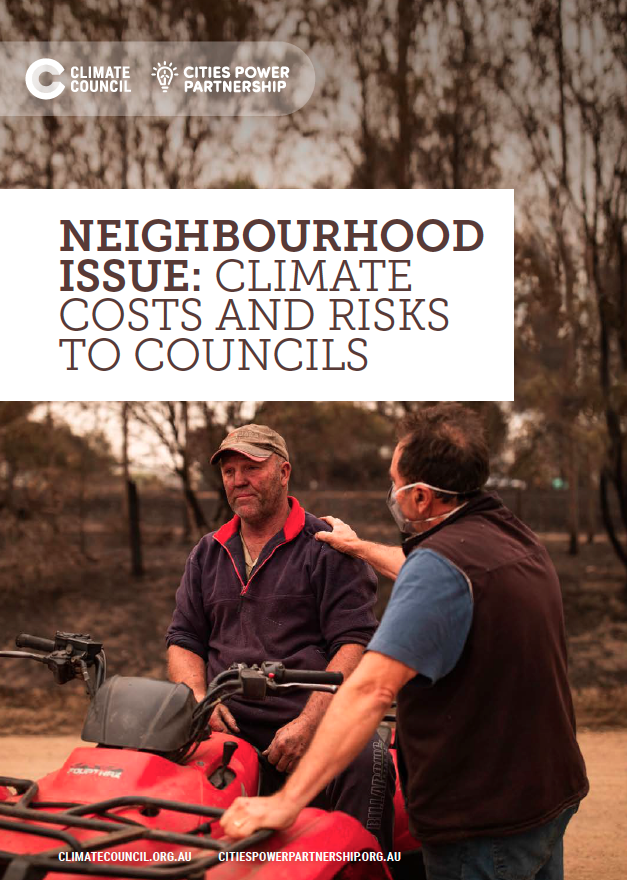No community within Australia remains untouched by climate change.
Our country is highly exposed to impacts including record-breaking heat, more dangerous bushfire seasons, coastal flooding and supercharged storms. These extreme weather events are worsening, and the impacts are reverberating throughout our communities.
As the level of government closest to the community, councils are at the heart of responding to climate impacts. When disaster strikes, local governments work closely with communities to cope and respond.
While we switch away from using coal, oil and gas there are climate impacts already baked into the system that councils must also respond to in order to keep our communities safe and strengthen their resilience into the future.
The findings and case studies in this report paint a picture of the impacts and scale of the challenge councils face, but also outline a pathway to overcome them. Additionally, it offers 22 recommendations for all levels of government, chief of which is for all levels of government to set more ambitious net-zero targets and act to drive down the burning of fossil fuels: coal, oil and gas.
Key Findings:
1. Climate change is an immense challenge for all levels of government, but its impacts are felt most acutely at the local level.
- Australia’s 537 councils are responsible for community infrastructure and assets valued at nearly half a trillion dollars, including land, buildings, and 75% of the nation’s roads.
- As the level of government closest to the community, council staff are often directly impacted by disasters and also required to respond. During Black Summer, one fifth of Towong Shire Council
staff were personally affected as the workforce took on extra duties and council resources were effectively exhausted within 72 hours. - As climate impacts – including coastal erosion, flooding, bushfire risks, and extreme storms – continue to accelerate, the risk to council infrastructure and services increases – as do community needs.
2. Worsening extreme weather, driven by climate change, is compounding costs for councils. This includes mounting damage to council owned assets, rising insurance premiums and increasing liability risks.
- Critical council infrastructure including roads, drainage and coastal defences, is being damaged by more frequent and/or severe extreme weather, and state and federal assistance is falling short of what’s required.
- Coastal councils are being forced to choose between competing interests in deciding how to protect their coastlines and communities from rising sea levels and worsening erosion. The bill for local governments to fix eroding beaches or protect beachside property or infrastructure commonly exceeds $1 million and could reach as high as $54 million per year.
- Claims and damages following extreme weather events are on the rise with average home insurance premiums rising 178% in northern Australia and 52% across the rest of the country in the decade between 2007-08 and 2018-19.
- A growing number of Australians have no insurance or inadequate insurance coverage for their property, which increases pressure on councils and the broader community to provide financial support in the wake of climate-fuelled disasters. Rates of noninsurance range from 17% in north Queensland (more than 62,000 properties) and as high as 40% in north Western Australia (more than 10,000 properties).
- One of the most common concerns for councils as climate impacts escalate is increasing litigation, with 21% of coastal councils surveyed in 2019 citing this as their highest concern. It’s virtually impossible for councils to eliminate such legal risks, but they can take steps to materially reduce them.
Find out if your council is a part of the Cities Power Partnership
3. Local government is playing a leading role in responding to climate change, but there are common barriers that councils face in trying to take further action.
- In Australia, local governments and communities are aligning with the latest climate science by working towards 100% renewable energy goals and zero emission targets. Already, the cities of Sydney, Melbourne, Brisbane and Adelaide have carbon neutral operations – as do Moreland and Darebin councils in Victoria.
- By cutting or avoiding greenhouse gas emissions, councils can also significantly cut operational expenses. For example, the Cities for Climate Protection program supported 233 councils to collectively avoid 18 million tonnes of carbon emissions and save $95 million in energy costs.
- Councils are effectively being asked to do more, with less. While council responsibilities – including those related to climate change – are growing, their tax revenue has shrunk to the fourth lowest share among the 30 industrialised nations that make up the Organisation for Economic Co-operation and Development.
- It is difficult for councils to access funding to prepare their communities for worsening extreme weather. Evidence shows the return on investment is higher for spending on disaster preparation rather than disaster recovery, yet 97% of all Australian disaster funding is spent in the wake of an event.
4. Protecting communities from worsening extreme weather, and minimising the costs borne by them, requires climate leadership at all levels of government.
- This report demonstrates that councils are already experiencing damage and loss beyond their ability to manage. Decisive and immediate action is required at all levels of government to deeply reduce fossil fuel emissions, increase the use of renewable energy and support communities to prepare for and cope with climate-fuelled disasters.
- Australia can and should do more as part of international efforts to keep global warming well below 2°C. This means cutting our emissions by 75% below 2005 levels by 2030, and reaching net zero emissions by 2035.
- Extreme weather events like bushfires and floods don’t respect municipal borders, so coordination from higher tiers of government is needed.
- There are big opportunities for councils when they have the resources to act on climate change. Beyond benefits to the community, action can create local jobs and result in long term savings for councils.




